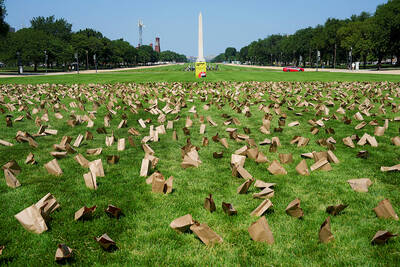The US dollar's rally stalled on Friday as a weaker-than-expected report on US payroll growth prompted a rethinking of the outlook for the world's biggest economy and future interest rates.
The euro rose to US$1.2229 at 9pm GMT from US$1.2270 late on Thursday in New York. At one point the single currency jumped as high as US$1.2390.
The US dollar dipped to ?107.71, from ?108.27 on Thursday.

PHOTO: AP
Markets shifted their focus away from Europe's woes and the defeat of constitutional referenda in France and the Netherlands, and got a jolt from a disappointing US labor report.
It was revealed that non-farm payrolls rose just 78,000 in May -- the lowest since August 2003.
Economists were expecting much stronger job growth during last month, forecasting an average gain of 186,000.
"Today's disappointing labor report showing a dismal 78,000 jobs in May -- lowest since August 2003 -- supports the notion that the emerging soft patch in the US economy is here to stay," said Ashraf Laidi, chief currency analyst at MG Financial Group.
The weak gain was interpreted by some market players as a sign that the Federal Reserve's current program of steady, quarter-point rate hikes is nearing an end. Higher rates would support the dollar.
But Brian Dolan, head of currency research at Gain Capital, said the dollar is still finding support in adverse developments for the euro, including the French and Dutch votes and some weak European economic reports.
The negative votes have raised concerns about the EU's integration process and will likely delay market reforms supportive of the euro.
"The current trend is still very much for the dollar to move higher," Dolan said.
"The market is using any dip, any pullback in the dollar as an opportunity. The dollar is still very well supported by the anti-euro sentiment that is carrying on after the referendum and the continued European weakness," he said.
The market had been positioned for a weak number but when the euro was bid higher, waves of sell orders also came in, analysts said.
"It is pretty clear at this point that the non-farm payrolls disappointment was not enough to force dollar bulls to capitulate their positions," said Michael Woolfolk at Bank of New York.
"Indeed, the report is far more positive than the headline number suggests," he said.
The euro's rally attempt on Friday was nipped by remarks from Italian Social Affairs Minister Roberto Maroni that Italy should consider re-introducing temporarily the lira alongside the single European currency.
He said the introduction of the euro has not been an adequate measure to tackle an economic slowdown and a decline in competitiveness in Italy.
The European constitution appears to be dead and buried after the French and the Dutch voted against its adoption in referendums, while reports earlier this week -- later denied -- suggested that German ministers had discussed the possible failure of monetary union.
European Central Bank and EU officials were quick to limit the damage caused by Maroni.
A spokeswoman for the European Commission said pointedly that the euro is "forever" while European Central Bank chief economist Otmar Issing warned that it would be "economically suicidal" for Italy to break out of the monetary union.
In late New York trade, the dollar stood at SF1.2533 from SF1.2514 on Thursday.
The pound was being traded at US$1.8146 from US$1.8151 late on Thursday.

Nvidia Corp chief executive officer Jensen Huang (黃仁勳) on Monday introduced the company’s latest supercomputer platform, featuring six new chips made by Taiwan Semiconductor Manufacturing Co (TSMC, 台積電), saying that it is now “in full production.” “If Vera Rubin is going to be in time for this year, it must be in production by now, and so, today I can tell you that Vera Rubin is in full production,” Huang said during his keynote speech at CES in Las Vegas. The rollout of six concurrent chips for Vera Rubin — the company’s next-generation artificial intelligence (AI) computing platform — marks a strategic

Shares in Taiwan closed at a new high yesterday, the first trading day of the new year, as contract chipmaker Taiwan Semiconductor Manufacturing Co (TSMC, 台積電) continued to break records amid an artificial intelligence (AI) boom, dealers said. The TAIEX closed up 386.21 points, or 1.33 percent, at 29,349.81, with turnover totaling NT$648.844 billion (US$20.65 billion). “Judging from a stronger Taiwan dollar against the US dollar, I think foreign institutional investors returned from the holidays and brought funds into the local market,” Concord Securities Co (康和證券) analyst Kerry Huang (黃志祺) said. “Foreign investors just rebuilt their positions with TSMC as their top target,

Enhanced tax credits that have helped reduce the cost of health insurance for the vast majority of US Affordable Care Act enrollees expired on Jan.1, cementing higher health costs for millions of Americans at the start of the new year. Democrats forced a 43-day US government shutdown over the issue. Moderate Republicans called for a solution to save their political aspirations this year. US President Donald Trump floated a way out, only to back off after conservative backlash. In the end, no one’s efforts were enough to save the subsidies before their expiration date. A US House of Representatives vote

REVENUE PERFORMANCE: Cloud and network products, and electronic components saw strong increases, while smart consumer electronics and computing products fell Hon Hai Precision Industry Co (鴻海精密) yesterday posted 26.51 percent quarterly growth in revenue for last quarter to NT$2.6 trillion (US$82.44 billion), the strongest on record for the period and above expectations, but the company forecast a slight revenue dip this quarter due to seasonal factors. On an annual basis, revenue last quarter grew 22.07 percent, the company said. Analysts on average estimated about NT$2.4 trillion increase. Hon Hai, which assembles servers for Nvidia Corp and iPhones for Apple Inc, is expanding its capacity in the US, adding artificial intelligence (AI) server production in Wisconsin and Texas, where it operates established campuses. This